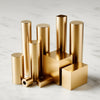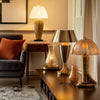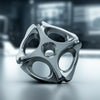Before You Buy Brass Hardware: Demand These Hidden Specs
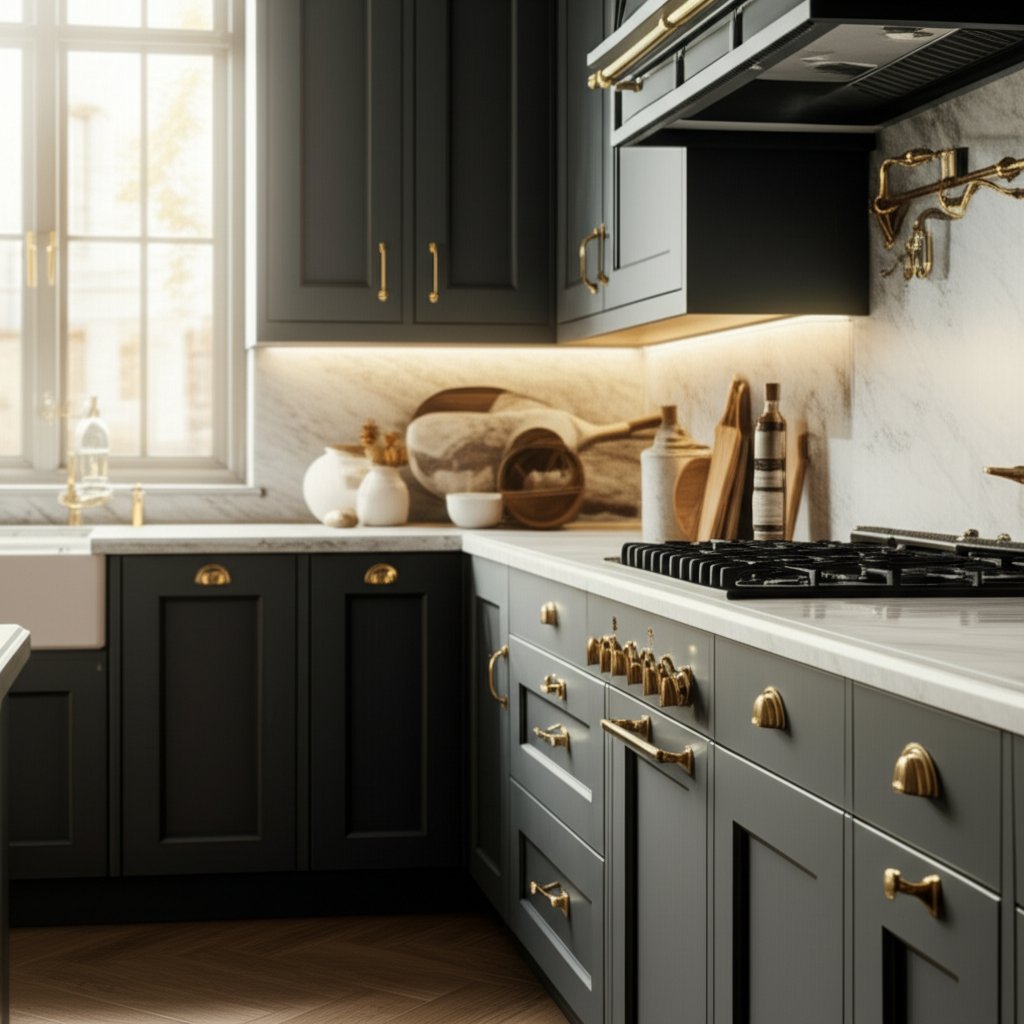
Brass Hardware Essentials That Elevate Spaces
Ever wondered why brass hardware continues to show up in both trendsetting interiors and timeless spaces? When you touch a brass knob or see the warm glow of brass cabinet hardware in a kitchen, you’re connecting with a material that’s been trusted for centuries. But what exactly makes brass the go-to choice for designers and homeowners alike? Let’s break down the essentials so you can shop with confidence—and avoid common pitfalls.
What Is Brass Hardware and Why It Endures
At its core, brass hardware is crafted from an alloy of copper and zinc. This unique blend gives brass its signature golden color and a balance of strength with workable machinability. The result? Hardware that’s not only durable but also easy to cast into detailed shapes for everything from brass knobs to intricate hooks and rails. Because brass is naturally resistant to corrosion and wear, it’s a smart pick for high-traffic areas like kitchens, bathrooms, and even furniture that sees daily use. Plus, brass can be recycled and remade, making it a sustainable option for eco-conscious buyers (source).
- Durability: Brass hardware stands up to frequent use and resists rust.
- Patina Potential: Over time, it develops a distinctive patina that many find beautiful.
- Tactile Comfort: The material feels solid and comfortable in hand, adding a sense of quality to daily routines.
Popular Categories From Brass Knobs to Drawer Pulls
Brass hardware isn’t limited to just one style or function. You’ll see it in:
- Brass cabinet hardware for kitchens and baths, including both knobs and pulls
- Hooks and rails for entryways or bathrooms
- Drawer pulls and handles on furniture, from dressers to sideboards
- Bath accessories like towel bars and tissue holders
Imagine upgrading a set of plain cabinets with brass cabinet pulls—suddenly, the whole room feels warmer and more inviting. Or, picture a bathroom where brass towel hooks add a subtle, cohesive touch. The versatility of brass means it transitions seamlessly from traditional to modern spaces.
Finish Choices and How They Affect Maintenance
Sounds complex? It doesn’t have to be. The finish you choose—whether it’s polished, brushed, or antique—will influence not only the look but also the care routine for your hardware. Solid brass can be refinished and restored over time, while brass-plated parts (which have only a thin layer of brass over another metal) may not hold up as well to heavy cleaning or refinishing. We’ll dive deeper into these differences and care tips in the sections ahead.
Choose finish and scale first, then style.
Ready to get started? Skim through key terms here, then jump to sections on finishes, installation, and maintenance for deeper guidance. This guide will arm you with the install specs, measurement templates, and care routines often missing from product pages—so you can select brass hardware that truly elevates your space and stands the test of time.
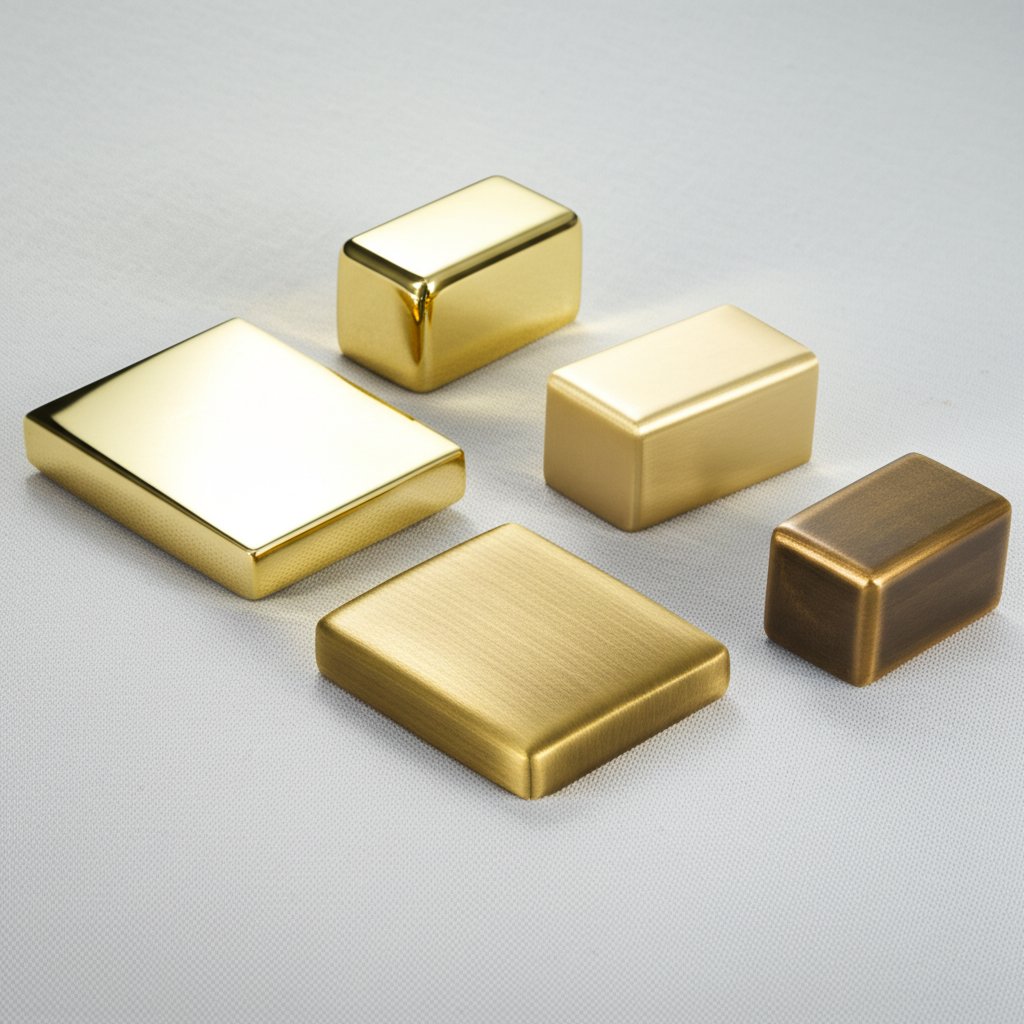
Finish and Patina Choices Made Simple
Ever picked up a shiny brass pull and wondered if it will stay that way? Or maybe you’ve seen hardware with a soft, worn-in look and asked yourself—how does that happen? Understanding the finish and patina of brass hardware is the secret to getting the look (and level of maintenance) that fits your lifestyle. Let’s break down the most popular finishes so you know exactly what to expect—no surprises after install.
Unlacquered Brass for a Living Patina
Unlacquered brass hardware is simply raw brass—no protective coating, just the real deal. Over time, it reacts with air, touch, and moisture, developing a unique patina that tells a story in every room. At first, you’ll notice fingerprints and smudges, but soon these blend into a rich, antique look. The more you use it, the more character it gains. Want it shiny again? A quick polish with a brass cleaner brings back the original glow. If you prefer a lived-in, low-maintenance vibe, unlacquered brass is for you (source).
Brushed and Satin Brass for Low-Glare Elegance
Love the warmth of brass but not the shine? Brushed brass hardware features fine brushstrokes that create a matte, textured surface. Satin brass hardware is similar but typically a bit smoother, with a muted gold-brown hue. Both finishes are excellent at hiding fingerprints and water spots, making them practical for busy kitchens and bathrooms. Their low-glare appearance pairs well with contemporary or transitional styles, and they blend beautifully with a variety of cabinet colors and countertop materials.
Polished Brass for High-Impact Shine
If you crave a classic, high-gloss look, polished brass hardware delivers. This finish is smooth, bright, and unmistakably traditional. It’s perfect for vintage-inspired spaces or when you want your hardware to be a focal point. However, polished brass does show fingerprints and water spots more easily, so a little extra care is needed to keep it gleaming. Most polished brass is lacquered, meaning the color stays consistent over time, but you should avoid abrasive cleaners to protect the surface.
Antique Brass: Instant Vintage Character
Antique brass finishes are treated to look aged right out of the box. They offer a deeper, brownish-gold tone that won’t change much over time—great for anyone who loves the patina look but prefers a stable, maintenance-free finish. Antique brass works especially well with classic cabinetry and adds warmth to both light and dark color palettes.
| Finish Type | Appearance | Maintenance | Patina Behavior | Best Use-Cases |
|---|---|---|---|---|
| Unlacquered Brass | Warm, golden; develops unique, darkened patina | Low or high (depending on if you polish) | "Living" finish, changes with touch and time | Traditional kitchens, vintage baths, statement furniture |
| Brushed Brass | Matte, textured, subtle gold | Low | Stable, minimal change | Modern kitchens, transitional spaces, busy areas |
| Satin Brass | Muted, gold-brown, soft sheen | Low | Stable, minimal change | Contemporary cabinets, mixed-metal schemes |
| Polished Brass | Bright, reflective, classic gold | Medium (shows fingerprints) | Stable if lacquered; may patina if unlacquered | Traditional rooms, statement hardware, period homes |
| Antique Brass | Brown-gold, aged look | Very low | Fixed aging, no further patina | Vintage-inspired, eclectic, and rustic interiors |
Match sheen across metals to avoid visual noise.
- Cabinet pairing tip: Use satin or brushed brass hardware for painted cabinets to keep the look soft and cohesive.
- Countertop tip: Polished brass pops against marble or quartz, while antique brass warms up wood or stone surfaces.
- Lighting tip: Align the sheen of your hardware with nearby fixtures—matte with matte, polished with polished—for a harmonious effect.
Choosing the right finish isn’t just about style—it affects how much you’ll need to clean, how your hardware will age, and how it will look with the rest of your space. Next, let’s explore how to select between knobs and pulls for function and comfort, so your hardware is as practical as it is beautiful.
Choosing Knobs and Pulls for Fit and Ergonomics
When you open a cabinet or drawer, do you instinctively reach for a knob or a pull? The choice between brass knobs and pulls is more than just a style decision—it’s about comfort, function, and the way your space feels in everyday use. Let’s explore how to make the right call for your kitchen, bath, or built-in furniture, so your brass hardware looks great and works even better.
Knobs vs Pulls by Drawer and Door Size
Sounds complex? It’s simpler than you think. Knobs are typically compact and attach with a single screw, making them ideal for upper cabinets or smaller doors where a quick grasp is all you need. Pulls, on the other hand, span a wider area and use two screws, which offers more leverage—perfect for heavier or wider drawers. This distinction isn’t just about looks: it helps you avoid awkward hand positions and ensures every cabinet is easy to use.
- Knobs excel on upper doors for quick grasp.
- Use pulls on lower cabinets and drawers for better grip and leverage.
- Mixing knobs and pulls creates both visual interest and ergonomic benefits.
For example, if you have a row of tall upper cabinets, brass cabinet knobs keep the look light and are easy to reach. On deep drawers below, brass drawer pulls provide the strength and comfort needed to open heavy loads—think pots, pans, or pantry items.
When Cup Pulls Shine on Drawers
Ever noticed those half-moon handles on classic kitchen drawers? Those are brass cup pulls, and they’re a go-to for both vintage and transitional spaces. Their shape lets you hook your fingers underneath for a secure, comfortable pull—especially handy on wide drawers. Cup pulls also hide fingerprints and feel smooth in hand, making them a favorite for high-traffic kitchens and mudrooms.
- Choose cup pulls for wide drawers or where you want a softer, period look.
- Pair with antique brass cabinet pulls for a cohesive, heritage-inspired scheme.
- Use slim bar pulls for a modern, streamlined effect on flat-front drawers.
Imagine a Shaker kitchen: brass cup pulls on the lower drawers and simple brass drawer knobs on the upper doors give a balanced, timeless look that’s also practical.
Ergonomics, Grip Comfort, and Clearance
When selecting brass pulls, don’t forget about hand clearance and projection (how far the hardware sticks out). Pulls should offer enough space so your fingers don’t scrape the cabinet, but not so much that they catch on pockets or clothing. For very wide drawers, consider using two pulls or one long pull that spans about one-third of the drawer’s width for even force distribution.
- Use two pulls on very wide drawers for balanced, easy opening.
- Test the grip—smooth edges and a comfortable profile matter for daily use.
- Match finish and shape to your cabinet style for a cohesive feel.
Here’s a quick example set for common cabinet widths and suggested hardware types:
| Cabinet Type | Recommended Hardware | Notes |
|---|---|---|
| Upper cabinet doors | Brass cabinet knobs | Easy to reach, simple grip |
| Standard drawers (medium width) | Brass drawer pulls | Comfortable leverage |
| Wide drawers | Two brass pulls or one long pull | Even weight distribution |
| Deep pantry drawers | Bar pulls or cup pulls | Secure grip, classic or modern style |
Let hand feel drive the final choice when styles look similar.
Remember, the best brass knobs and pulls are the ones that feel right in your hand and suit the way you use your space. Whether you’re aiming for the elegance of antique brass cabinet pulls or the modern simplicity of slim brass pulls, comfort and proportion should always come first. Next, we’ll dive into installation specs and drilling templates so your new hardware fits perfectly and functions flawlessly.
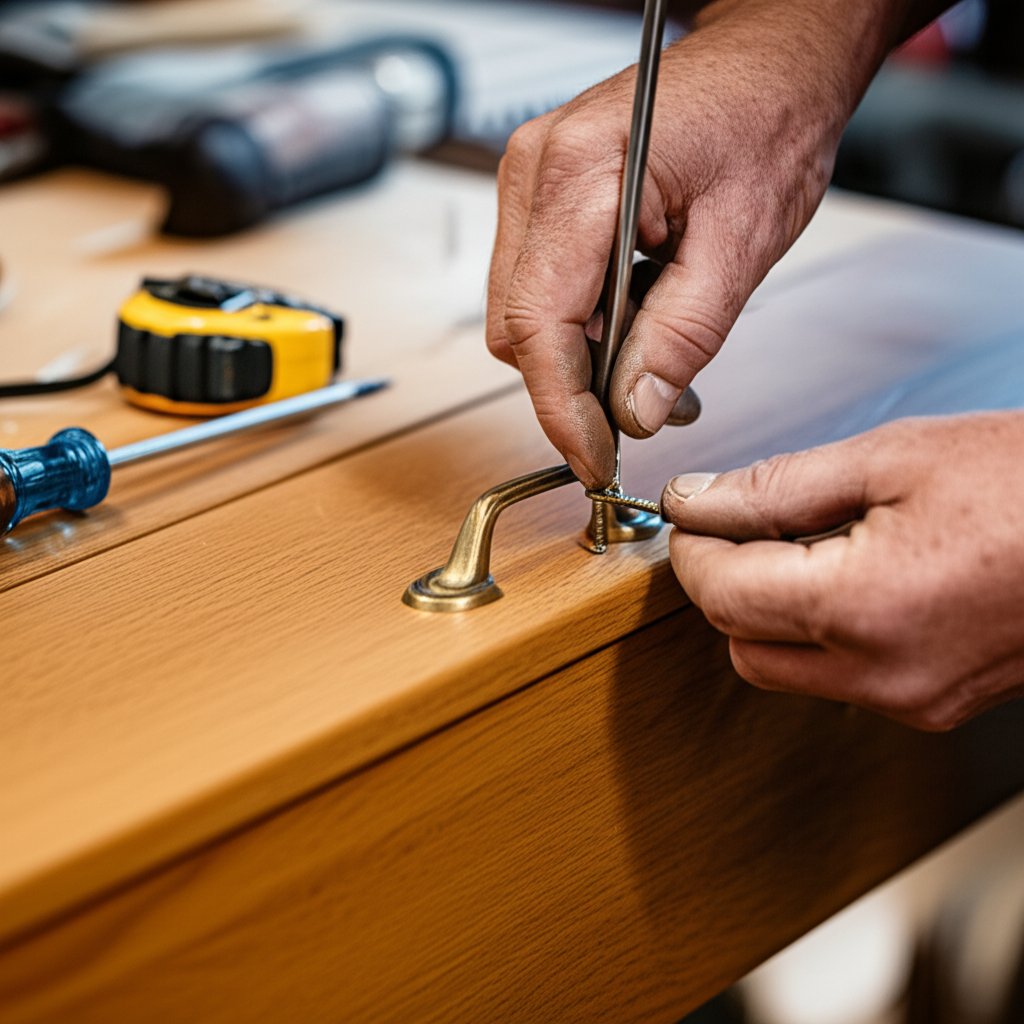
Installation Specs and Drilling Templates That Work
Ever worry about crooked pulls or wobbly knobs ruining your new cabinets? Installing brass hardware like unlacquered brass cabinet pulls or a satin brass cabinet pull doesn’t have to be nerve-wracking. With a clear plan, the right tools, and a few pro tips, you can achieve a flawless, professional look—without the stress. Here’s how to get every brass cabinet pull perfectly placed and securely fastened, step by step.
Accurate Center to Center Measurements
When you’re installing brass cabinet hardware pulls, precision is key. The “center to center” (C-C) measurement is the distance between the screw holes on your pull. Most standard pulls—like 3 inch brass cabinet pulls—have a 3-inch C-C, but always confirm this on your hardware package or product page. If you’re replacing old hardware, match this measurement to avoid patching holes. For new installations, templates or jigs are your best friend: they ensure every pull and knob is placed at the same height and distance, so your kitchen or bath looks balanced and intentional (source).
- Choose your hardware and confirm the C-C measurement for each pull.
- Use a store-bought or DIY template to mark hole locations on each cabinet or drawer. For custom sizes—like longer brass cabinet pull handles—make a template that matches your drawer’s width.
- Mark with a pencil, double-checking level and alignment across adjacent doors and drawers.
Pilot Holes and Screw Selection
Drilling the right pilot hole prevents splitting and makes hardware installation easier. Check your hardware’s packaging for the recommended drill bit size—commonly 3/16" for most pulls, but always verify. Drill from the front to the back of the cabinet to minimize visible splintering. For added protection, place painter’s tape or blue tape on the back side of the panel before drilling; this helps keep the wood intact and prevents chipping.
Matching screw length to your drawer or door thickness is crucial. Here’s a general guide:
| Panel Thickness | Recommended Screw Length | Common Head Types |
|---|---|---|
| 3/4" (standard cabinet) | 1" - 1-1/4" | Flathead, Phillips or Square |
| 1" (thicker drawer front) | 1-1/4" - 1-1/2" | Flathead, Phillips |
| 5/8" (thin panels) | 3/4" - 1" | Flathead |
Tip: If your hardware comes with brass screws, pre-thread the hole using a steel screw first to avoid stripping or snapping the softer brass (source).
- Drill pilot holes using the correct bit size and depth for your screws.
- Insert screws from the inside of the cabinet or drawer and tighten gently. Use a hand screwdriver for the final turns to avoid over-torquing and damaging the finish on your satin brass cabinet pull or brass cabinet pull with backplate.
- For extra security, apply a dab of blue threadlocker (like Loctite) to the screw threads before tightening. This helps prevent loosening over time.
Mounting Pitfalls to Avoid
- Always double-check alignment before drilling—uneven hardware draws the eye and can be tough to fix.
- Don’t overtighten screws; this can strip threads or crack delicate finishes.
- Use backplates if you’re covering old holes or want to add a decorative accent. A brass cabinet pull with backplate can also help distribute force and protect painted surfaces.
- Protect your hardware’s finish by using blue tape around the install area until all drilling and fastening is complete.
Measurement Worksheet: Center-to-center: ________ | Projection: ________ | Diameter/Width: ________ | Edge setback: ________ | Hardware count: ________
Installing brass cabinet hardware pulls or unlacquered brass cabinet pulls doesn’t have to be intimidating. With a template, careful measurements, and a few finishing touches, you’ll get a result that’s both beautiful and durable. Next, let’s look at how material choices—solid brass versus plated—impact the long-term value and feel of your hardware.
Solid Brass Versus Brass Plated
When you pick up a piece of brass hardware, can you tell if it’s solid brass or just brass-plated? The difference isn’t always obvious at first glance—but it matters a lot for how your hardware will look, feel, and last over time. Let’s break down what sets solid brass hardware apart from plated or brass-finish options, so you can make the right investment for your home.
Solid Brass Benefits and Tradeoffs
Imagine opening a drawer and feeling the reassuring weight of solid brass cabinet pulls—it’s a small luxury you’ll notice every day. Solid brass is an alloy of copper and zinc, prized for its strength, density, and resistance to corrosion. Here’s why it’s often considered the gold standard for solid brass cabinet hardware:
- Durability: Solid brass stands up to decades of use, resisting rust and corrosion—even in bathrooms and kitchens where moisture is a daily challenge.
- Refinishable: If the finish wears or you want a new look, solid brass can be polished or refinished, restoring its shine or adapting it to a new style.
- Weight and Feel: You’ll notice a satisfying heft and smoothness—solid brass cabinet knobs feel substantial, not hollow or tinny.
- Timeless Look: Brass develops a natural patina over time, adding character and vintage appeal if left unlacquered.
Pros:
- Exceptional longevity and strength
- Can be refinished or repaired
- Rich, authentic patina develops with age
- Feels solid and luxurious in the hand
Cons:
- Higher upfront cost compared to plated hardware
- Heavier weight may not suit all furniture or doors
Plated and Brass Finish Options Explained
On the other hand, many hardware pieces are made from steel, zinc, or other metals, then coated with a thin layer of brass. These brass-plated or “brass finish” items are designed to mimic the look of solid brass, but there are some important differences:
- Budget-Friendly: Plated hardware is typically less expensive, making it a tempting option for large projects or quick updates.
- Lighter Weight: Plated pieces often feel lighter and may sound hollow when tapped—something you’ll notice with frequent use.
- Finish Longevity: The brass layer can wear through over time, especially on high-touch areas. Once the underlying metal is exposed, it may corrode or look dull.
- Refinishing Limitations: Unlike solid brass, plated hardware can’t be sanded or polished back to new once the finish is damaged.
Pros:
- Lower cost for budget-conscious projects
- Wide variety of styles and finishes
- Lighter weight for delicate doors or furniture
Cons:
- Finish can chip, flake, or wear through
- Cannot be refinished or repaired if damaged
- May feel less substantial and luxurious
How to Spot Quality in Hand Feel and Threads
So, how do you know what you’re getting? Here are a few quick tests and tips from antique hardware experts:
- Weight Test: Solid brass hardware feels noticeably heavier than plated pieces of the same size.
- Magnet Test: Brass is not magnetic. If a magnet sticks, it’s likely plated steel, not solid brass.
- Scratch Test: In an inconspicuous spot, gently scratch the surface. If the color beneath is yellow-gold, it’s solid brass. If you see silver or gray, it’s plated.
- Thread Quality: Solid brass hardware often features crisp, well-cut threads. Plated items may have rougher, mass-produced threads that strip more easily.
If finish longevity matters, prioritize solid brass and serviceable fastener threads.
Choosing between solid brass hardware and plated alternatives comes down to your project goals and budget. Solid brass is an investment in long-term beauty and durability—ideal for cabinetry and fixtures you’ll touch every day. Plated options can still look great, especially when you want to refresh a space affordably, but be mindful of their limitations. Next, let’s talk about how to keep your brass hardware looking its best with easy care and troubleshooting tips.
Care Maintenance and Troubleshooting for Long Life
When you invest in beautiful brass hardware, you want it to look and feel great for years. But what happens when fingerprints dull the shine, a knob loosens, or your unlacquered brass develops a patchy patina? Sounds complex? Let’s break it down with an easy care schedule, safe cleaning tips, and troubleshooting steps—so whether you have unlacquered brass cabinet hardware, polished brass cabinet hardware, or cherished aged brass hardware, you’ll know exactly how to keep it at its best.
Simple Cleaning Routine: Daily to Yearly
Imagine opening your cabinet and seeing gleaming hardware every time. That’s possible with just a few simple habits. Here’s a practical routine for all types of brass hardware, including polished brass cabinet knobs and unlacquered brass knobs:
- Daily: Wipe hardware with a soft, dry cloth to remove fingerprints, dust, and oils. This prevents buildup and keeps the finish looking fresh.
- Weekly: For more stubborn spots, use a soft cloth dampened with mild soap and water. Gently wipe, then dry immediately to avoid water spots.
- Monthly: Apply a non-abrasive furniture or automotive wax. Let it dry, then buff with a clean, soft cloth. This helps maintain the luster, especially for cabinet hardware polished brass.
- Yearly (or as needed): Polish with a brass-specific cleaner if tarnish appears. For polished brass pulls, use gentle, circular motions and avoid harsh abrasives to protect any lacquered coating.
Tarnish and Patina Management
Wondering why your hardware changes color over time? That’s patina—a natural process, especially with unlacquered brass cabinet hardware and aged brass hardware. Some love the character it brings, while others prefer a bright shine. Here’s how to care for each look:
- To encourage patina: Simply clean with a dry cloth and avoid polishing. Let the hardware age naturally for a lived-in, vintage feel.
- To maintain shine: Use a brass polish (like Brasso) applied with a soft cloth. Buff gently and rinse any residue. For high-touch areas, a thin coat of natural oil (olive or linseed) can slow tarnishing (source).
- For patchy or uneven patina: Mix baking soda with lemon juice or vinegar to form a paste. Apply with a soft cloth or toothbrush, then rinse and dry. This can even out the finish without stripping all the character.
- For polished brass cabinet hardware: Avoid ammonia, bleach, or harsh abrasives, as these can damage lacquered finishes and cause dull spots.
Test cleaners on hidden areas first.
- Never use: ammonia, bleach, vinegar (for lacquered brass), or abrasive pads. These can scratch or strip the finish.
- Always use: soft, non-abrasive cloths; mild soap; and gentle waxes.
Fixing Loose Hardware and Stripped Threads
Sometimes, even the best hardware gets loose or wobbly. Here’s how to fix common issues—no need to panic or call a pro:
- Loose knobs or pulls: Tighten screws gently with a hand screwdriver. For persistent loosening, add a drop of blue threadlocker to the screw before reinstalling.
- Stripped wood holes: Insert a toothpick or wood dowel coated with wood glue into the hole, then reinsert the screw once dry. This gives the screw new grip and stability.
- Scratched or dulled polished brass pulls: Lightly polish with a brass cleaner and soft cloth, being careful not to rub through any lacquered coating. For cabinet hardware polished brass, always polish in the direction of the grain or brush marks, if present.
- Re-waxing or re-lacquering: If your hardware loses its protective layer, reapply a non-abrasive wax monthly. For major wear, consult a professional for re-lacquering.
By sticking to these routines, you’ll keep your unlacquered brass knobs, polished brass cabinet knobs, and every piece of brass hardware looking its best—whether you love a glowing shine or a rich, aged patina. Next up, we’ll cover the technical specs you should check before ordering, so your new hardware fits perfectly and lasts as long as your care routine does.
Spec Sheets and Data Buyers Should Demand
Ever ordered beautiful brass cabinet drawer pulls only to find they don’t fit your cabinets—or realized too late that the screws are too short for your drawer fronts? You’re not alone. The secret to a frustration-free hardware upgrade is a simple, thorough spec sheet. Before you click “buy,” collecting the right technical details helps you avoid mismatches, return headaches, and extra holes in your cabinetry. Here’s how to get it right the first time, whether you’re choosing brass hardware pulls, a single brass cabinet knob, or a full set of brass cabinet handles.
The Spec Sheet That Saves You Headaches
Sounds complex? Let’s break it down. Every piece of hardware—pull, knob, or handle—should have a clear list of specs. This isn’t just for pros; it’s the best way for anyone to ensure a perfect fit and finish. Here’s what you should always confirm before ordering:
- Material: Is it solid brass, brass-plated, or another metal? Solid brass offers durability and refinishing potential.
- Finish: Polished, brushed, satin, antique, or unlacquered—each affects appearance and care.
- Dimensions: Overall length, diameter (for knobs), projection (how far it sticks out), and center-to-center (CTC) for pulls.
- Mounting Type: Through-bolt, surface mount, or concealed fixings.
- Screw Size/Length: Match to your cabinet or drawer thickness (see install chapter for tips).
- Weight: Especially important for large pulls or brass handle rails.
- Load Rating: For hooks, rails, or anything that will bear weight.
- Included Hardware: Screws, backplates, washers—know what’s in the box.
Dimensional Details You Must Confirm
Imagine you’re replacing old brass cabinet handles. The most common mistake? Confusing overall length with center-to-center (CTC) spacing. For example, brass 3 inch cabinet pulls usually refer to the CTC—the distance between the screw holes—not the total length of the pull. If your cabinets are already drilled, matching the CTC is non-negotiable. If you’re starting fresh, consider the scale and projection so the hardware feels balanced and comfortable in hand.
| Spec Item | Your Requirement | Product Listing | Verified |
|---|---|---|---|
| Material | Solid brass | __________ | □ |
| Finish | Brushed, polished, etc. | __________ | □ |
| Overall Length | __________ | __________ | □ |
| Center-to-Center (CTC) | __________ | __________ | □ |
| Projection | __________ | __________ | □ |
| Diameter/Width | __________ | __________ | □ |
| Mounting Type | __________ | __________ | □ |
| Screw Size/Length | __________ | __________ | □ |
| Weight | __________ | __________ | □ |
| Load Rating | __________ | __________ | □ |
| Included Hardware | Screws, backplates | __________ | □ |
Use this table as a checklist when comparing products. If a detail is missing from the product page, don’t hesitate to contact the supplier or request a datasheet. For specialty items—like heavy-duty brass hardware pulls or extra-long brass cabinet handles—ask about weight ratings and fastener compatibility to ensure safe, long-term use (source).
Always verify center-to-center and projection before drilling.
What’s Included and What You’ll Need
Some hardware sets arrive with all the screws and backplates you’ll need. Others may require you to purchase longer screws for thick drawer fronts or special anchors for wall-mounted rails. Double-check what’s in the box and what you may need to source separately. For example, a brass cabinet knob might come with a standard 1-inch screw, but if your door is thicker, you’ll want a longer one. Likewise, for brass 3 inch cabinet pulls, confirm both the CTC and that the supplied screws match your cabinet thickness.
- Check product listings for included hardware—look for phrases like "all mounting hardware included."
- For wall-mounted hooks or rails, ask about weight/load ratings and recommended anchors.
- For custom cabinetry, consider ordering a few extra pieces for future repairs or replacements.
By gathering these key specs—material, finish, dimensions, mounting, and included hardware—you’ll ensure your new brass hardware fits perfectly and functions beautifully. Next, we’ll explore when it makes sense to go custom, especially if you need unique sizes, profiles, or want to match legacy pieces with precision machining.
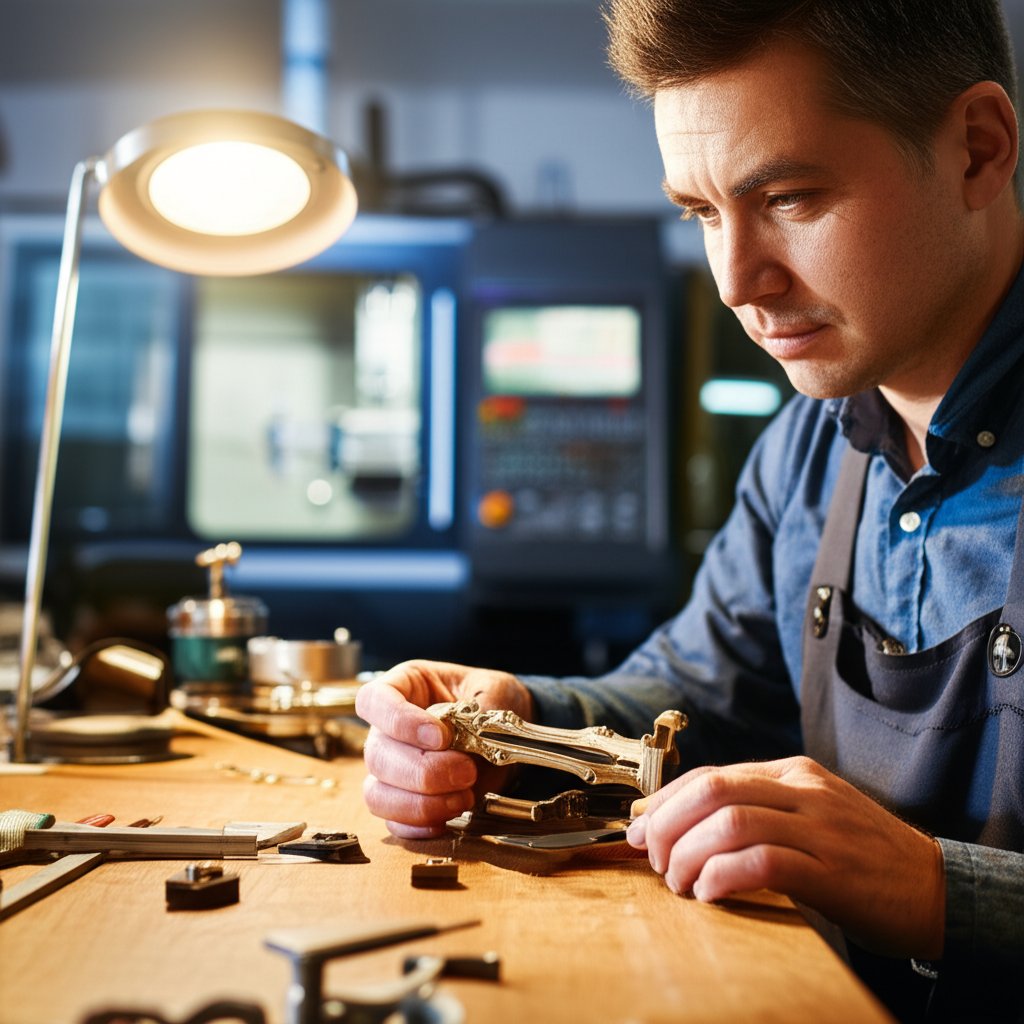
When to Go Custom with CNC Machined Brass Parts
Ever struggled to find a brass knob that matches your century-old built-in, or needed brass gallery rails with a very specific profile or length? When off-the-shelf brass hardware just won’t cut it, custom CNC machining opens up a world of possibilities for designers, renovators, and anyone who wants a perfect fit—no compromises.
When to Go Custom for Brass Hardware
Imagine you’re restoring a vintage hutch and the original brass rails are missing. Or maybe you’re designing a modern kitchen with a unique island that needs rail end hardware in a finish and size that’s nowhere to be found. In these moments, custom CNC machining is your best ally. It’s ideal for:
- Matching legacy hardware profiles or rare dimensions
- Creating bespoke brass gallery rails or brass railing for shelving, bars, or furniture
- Designing custom hardware for tight spaces or unusual mounting requirements
- Producing a consistent set of knobs, pulls, or brass rack components for a large project or commercial application
With CNC machining, you can specify every detail—length, diameter, post style, finish, and even the type of mounting hardware. This flexibility ensures your custom hardware fits perfectly and elevates the entire space.
CNC Precision for Complex Profiles and Tight Tolerances
Sounds complex? CNC (computer numerical control) machining makes it simple. Using computer-guided cutting tools, manufacturers can replicate intricate details, produce ultra-tight tolerances, and ensure repeatable quality from the first prototype to the last production piece. For example, a CNC shop can craft brass rails with perfectly matched rail end hardware, ensuring every post, rod, and bracket lines up exactly—even across a long run of cabinetry or shelving.
According to Brass Hardware, CNC machining is especially suited for small-batch or high-complexity projects where casting or mass production isn’t practical. This is echoed by Palmer Industries, who use CNC machined solid brass posts to achieve crisp details and a perfect fit on custom gallery rail systems.
From Prototype to Production Without Compromise
Still unsure if you need custom CNC parts or can get by with off-the-shelf? Here’s a side-by-side comparison to help you decide:
| Provider / Method | Fit & Customization | Lead Time | Finish Control | Repeatability | Certifications |
|---|---|---|---|---|---|
| XTJ CNC Machining Services | Fully custom: any size, profile, or mounting for brass rails, hardware, or brass rack parts | Rapid: lead times from 3 days for prototypes or production | Complete: choose from a wide range of finishes and materials, including brass | Exceptional: ISO 9001 & IATF 16949 certified, ±0.005mm tolerance | ISO 9001, IATF 16949 |
| Other Custom CNC Shops | Custom fit, but may have limits on finish or complexity | Varies; often longer for complex jobs | Typically offer several standard finishes | Good; depends on shop capability | Varies |
| Off-the-Shelf Hardware | Standard sizes and profiles only; limited to stock options | Immediate if in stock | Limited to available finishes | Consistent, but only for standard designs | Not always listed |
Custom CNC machining is the answer when you need a perfect fit, unique design, or repeatable quality for every piece.
Whether you’re restoring antique shelving, fitting new brass gallery rails to a custom bar, or building a brass rack for a boutique retail space, XTJ CNC machining gives you control over every detail. It’s the only way to guarantee your custom hardware will match legacy pieces, work with existing holes, and maintain finish consistency across an entire project.
Curious if CNC is right for your next project? Consider it for non-standard dimensions, heritage matches, or when repeatable quality across large orders is critical. With the right partner, you can transform your vision into reality—delivering brass hardware that fits, functions, and endures for generations.
Brass Hardware FAQs
1. Is brass good for kitchen hardware?
Yes, brass is an excellent choice for kitchen hardware due to its natural resistance to corrosion and wear. Its strength and durability make it ideal for high-traffic areas like kitchens, ensuring longevity and a timeless look. Brass also develops a unique patina with use, adding character to your kitchen over time.
2. Is brass a luxury metal?
Brass is often associated with luxury because of its warm, gold-like appearance and substantial feel. While it is more affordable than precious metals, its visual appeal and tactile comfort make it a favorite for upscale interiors and classic design schemes.
3. How do I choose between brass knobs and pulls for my cabinets?
Select knobs for upper cabinets and smaller doors for quick, easy grasping. Pulls are better for wide or heavy drawers, offering greater leverage and comfort. Consider ergonomics, the size of your cabinetry, and your design style to ensure both function and aesthetics.
4. What’s the difference between solid brass and brass-plated hardware?
Solid brass hardware is made entirely from brass alloy, offering superior durability, weight, and the ability to refinish or repair the surface. Brass-plated hardware uses a thin brass coating over another metal, making it lighter and more budget-friendly but less durable and harder to restore if the finish wears off.
5. How should I care for and maintain brass hardware?
For daily care, use a soft, dry cloth to wipe away fingerprints and dust. For deeper cleaning, use mild soap and water, then dry immediately. Apply non-abrasive wax monthly for extra protection. Avoid harsh chemicals like ammonia or bleach, and regularly check for loose screws or hardware to ensure longevity.
-
Posted in
brass hardware, brass knobs and pulls, cabinet hardware, hardware installation, solid brass

